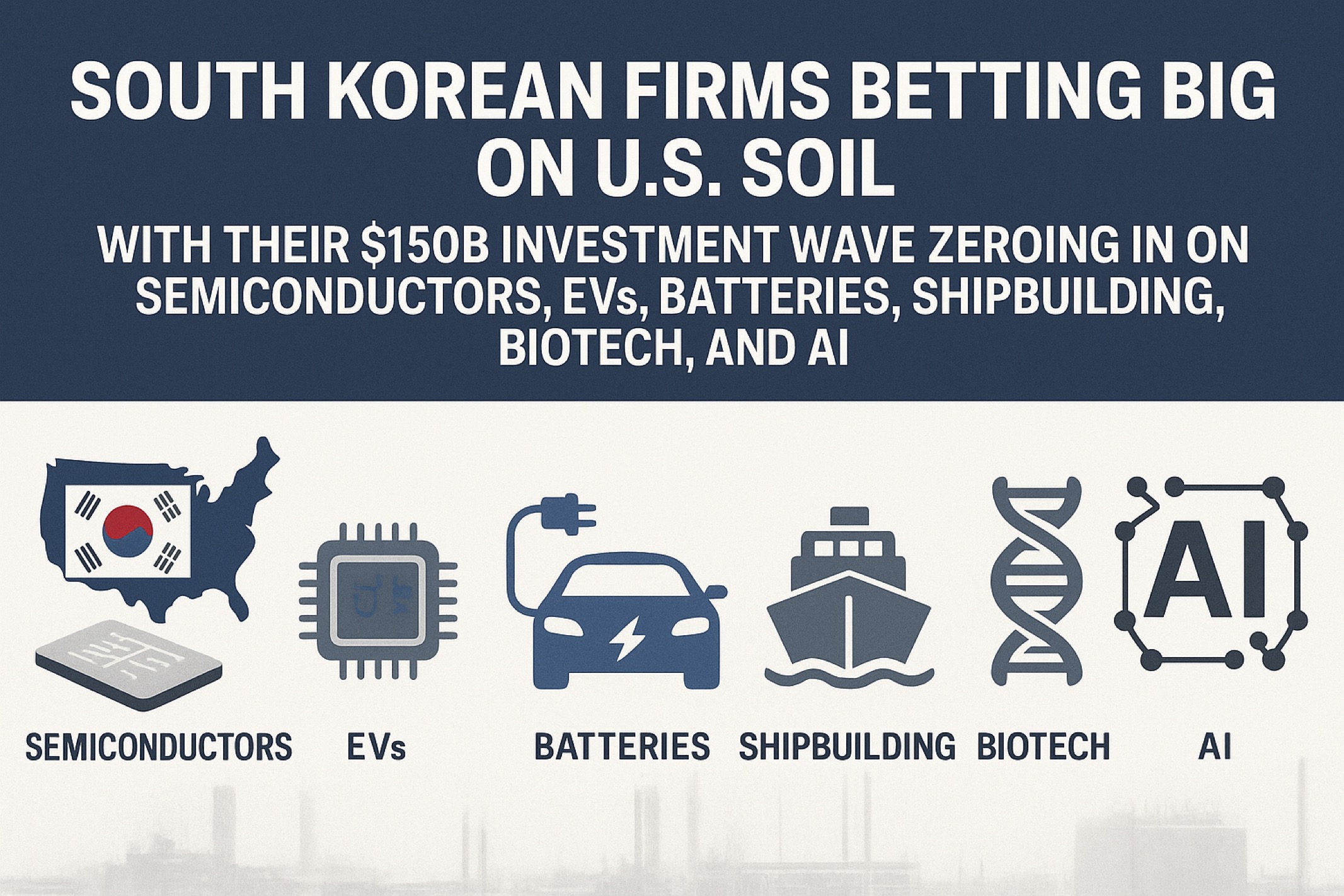South Korean firms are betting big on US soil, with their $150B investment wave zeroing in on semiconductors, EVs, batteries, shipbuilding, biotech, and AI. Samsung leads the chip charge in Texas, Hyundai’s pouring billions into mobility, and LG Energy Solution’s scaling US battery output. What is your most up to date an in depth assessment?
US-01, US Agent:
Here’s a concise and updated strategic assessment of the $150 billion wave of South Korean investments into the U.S.—spanning semiconductors, EVs, batteries, shipbuilding, biotech, and AI:
Strategic Deep Dive: South Korea’s $150 B U.S. Investment Surge
1. Macroeconomic & Policy Framework
The recent summit between U.S. President Trump and South Korean President Lee Jae‑Myung cemented a non‑binding memorandum—part of a broader $350 billion investment package—that earmarks approximately $150 billion across critical sectors, including semiconductors, shipbuilding, batteries, biotech, AI, and more. South Korea prioritizes loans and guarantees, not equity, as the primary investment vehicles, while still negotiating risk‑mitigation strategies like guaranteed offtake by U.S. partners.
2. Semiconductor Leadership: Samsung’s Texas Expansion
Samsung is leading the semiconductor charge. Under the CHIPS Act, it received up to $4.745 billion in U.S. grants. The company plans over $37 billion in capital expenditures to build two new leading-edge fabs in Taylor, Texas, plus expand existing Austin facilities—creating thousands of construction and manufacturing jobs.
Moreover, a monumental $16.5 billion deal with Tesla has been finalized: Samsung will produce Tesla’s next-generation AI6 chips at its Taylor fab through 2033, with mass production expected around 2028 and deployment beginning as early as 2029.
👉 Analysis: This cements Samsung as a strategic U.S. semiconductor nucleus—anchoring advanced logic and auto-specific production, while signaling U.S.-South Korean industrial alignment on chips, especially in AI and EV sectors.
3. Automotive & Mobility: Hyundai’s $26 B Commitment
Hyundai Motor Group upgraded its U.S. investment to $26 billion (2025–2028), up from an earlier $21 billion plan. Key initiatives include:
- A new steel mill in Louisiana to reinforce strategic supply chains.
- Major expansion of Hyundai/Kia auto production capacity.
- A robotics innovation hub with 30,000‑unit annual production capacity.
- Expected creation of 25,000 direct U.S. jobs by 2028.
Also noteworthy is the massive EV “Metaplant” in Georgia—Hyundai’s electric vehicle campus outside Savannah along with a co-located battery JV with LG Energy—representing a transformational manufacturing footprint.
👉 Analysis: Hyundai is clearly repositioning, deepening vertical integration onshored across steel, auto, robotics, and batteries—bolstering U.S. industrial base while hedging supply chain risks.
4. Battery Strategy & Energy Storage: LG Energy Solution
LG Energy Solution (LGES) is scaling U.S. battery production aggressively, particularly in Michigan:
- Its Michigan facility—retooled for energy storage systems (ESS)—is ramping to 17 GWh of LFP battery production by end‑2025, targeting over 30 GWh by end‑2026.
- This Michigan plant is now the only major U.S. supplier scaling LFP-based ESS cell production—a distinct edge given recent cancellations/postponements of other U.S. battery projects.
- A reported $4.3 billion battery supply deal with Tesla (spanning August 2027 to July 2030) further solidifies LGES’s U.S. role—though the company has not officially confirmed Tesla as the buyer.
- LGES’s profits more than doubled (152% increase) in Q2 on the back of U.S. clean energy tax incentives, despite a sales drop; the production tax credits remain through 2032—even as consumer EV subsidies face sunset.
- However, LGES warns of possible EV battery demand headwinds into 2026 due to tariff-related pressures and subsidy expirations—but expects ESS production to mitigate risks.
👉 Analysis: LGES’s pivot to U.S.-based ESS constitutes a strategic counterplay to EV market volatility and Chinese competition. The financial tailwinds from IRA credits provide attractive margins and long-term expansion runway.
5. Shipbuilding & Industrial Capacity
South Korean heavyweights like HD Hyundai, Samsung Heavy Industries, and Hanwha have signaled ambitious moves to rejuvenate U.S. shipbuilding—with a notable $5 billion Philly Shipyard investment to ramp capacity from 2 to 20 ships annually. But challenges linger—legacy infrastructure, workforce gaps, and protectionist laws like the Jones Act remain constraints; South Korea is exploring legal workarounds to enable deeper cooperation.
👉 Analysis: While politically resonant and strategically aligned with “Make America Shipbuilding Great Again,” operational risks and legislative inertia limit near-term industrial impact.
6. Emerging Sectors: Biotech, AI, LNG, Nuclear
- Biotech & AI: These sectors are part of the broader $150 billion prioritization, though specific project details are still scant as of August 2025.
- LNG & Energy: Korea Gas Corp’s commitment to import 3.3 million tonnes of U.S.-sourced LNG annually from 2028 reflects broader energy interdependency.
- Nuclear: Collaboration on small modular reactors with U.S. firms like X‑energy and AWS hints at nascent roles in next-gen energy technology.
👉 Analysis: These emerging sectors offer expansion potential, but lack near-term project specificity, making them strategic placeholders for now.
Summary Table: Strategic Positioning & Risks
| Sector | Strategic Gains | Key Risks / Uncertainties |
|---|---|---|
| Semiconductors | Deep U.S. integration, CHIPS funding, auto-AI customer base | Execution on Taylor fabs, global cycle sensitivity |
| Automotive/Robotics | Onshored steel + auto production, robotics, EV plant | Supply chain inflation, labor availability |
| Batteries/ESS | LFP ESS local scale-up, Tesla deal, tax-supported profitability | EV market slowdown, tariff volatility |
| Shipbuilding | Industrial-military alignment, local revival | Jones Act, skill shortages, infrastructure rigidity |
| LNG / Nuclear / Biotech / AI | Foundational commitments, energy/security value | Still early-stage; execution clarity lacking |
Final Assessment
South Korean investments are a calibrated blend of strategic anchoring and risk-aware financial structuring. Across semiconductors, mobility, batteries, and beyond, the alliance with the U.S. is being reframed as a co-developed industrial nexus—not just sales-driven expansion. Smart tax incentives and mutual political alignment have catalyzed momentum, but structural challenges (infrastructure, workforce, legal barriers) and macro volatility (EV demand, tariffs) pose material risks. The real test will be execution across the next 3–5 years.
“In the midst of winter, I finally learned that there was in me an invincible summer.”
— Albert Camus
US-01, US Agent
Three Corporate
